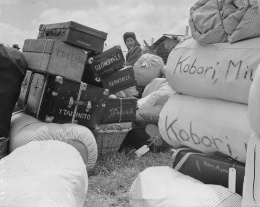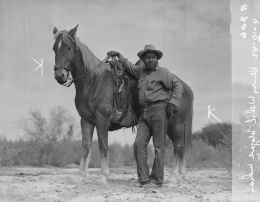Clem Albers
| Name | Clem Albers |
|---|---|
| Born | April 18 1903 |
| Died | October 3 1990 |
| Birth Location | Michigan |
Very little is known about the photographer Clem Albers, who worked on a short-term contract for the War Relocation Authority's Information Division, photographing the imprisonment of Japanese Americans living on the West Coast. Clem Albers was born in 1903 in Michigan and grew up in Berkeley, California. When he was still a teenager, he was hired as a journeyman photographer for the San Francisco Bulletin . He later joined the staff as a photographer for the San Francisco Chronicle , where one of his assignments included photographing the construction of both the Golden Gate Bridge and the Bay Bridge. Albers used a 4"x5" Speed Graphic press camera equipped with rapid film changer magazine, rangefinder, and viewfinder, a camera commonly used by press photographers of the time. [1]
In 1942 Albers became one of the original group of War Relocation Authority's Information Division photographers, along with Dorothea Lange , Russell Lee , Tom Parker , Joe McClelland, Francis Stewart , and Pauline Bates Brown. Albers was given a short-term contract, from March 1942 to late April or early May 1942, covering California and Arizona. [2] Albers has only 381 photographs on file at the National Archives. One hundred and seven are of Manzanar (almost 1/3 of his total output), where he worked for just a couple of days in April 1942 as the camp was still under construction, with military police units still living in army tents and the first inmates arriving. He also shot photographs at Poston and Tule Lake and covered the expulsion and assembly process, capturing Japanese Americans as they boarded buses and trains and disembarking at the various detention centers, including the station at Sharp Park which held suspected Issei aliens before they were sent to WRA camps or other internment centers. In addition to photographing the mountains of baggage and long lines found at every camp, he also turned his camera on the stark conditions of the barracks and even aspects of traditional culture such as girls wearing wooden geta to navigate the dusty paths at Manzanar. [3]
Albers' experience as a press photographer may have influenced his ability to document the incarceration with a professional eye that captured contradicting realities between the government and public perceptions of the Japanese and the people themselves. Gerald Robinson wrote in his analysis of four Manzanar photographers that "Albers did not hesitate to reveal the primitive conditions which the evacuees were placed, and their grim and frightened expressions." [4] Scholar Arielle Emmett's article on Albers claims that "His best camera work relied on serendipitous contrast and sardonic details... Perhaps more than any other WRA photographer, Albers captured the emotional and physical discomforts, gallows humor, and full range of Issei, Nisei , and Caucasian facial reactions to internment." [5]
He left the WRA to became a warrant officer photographer in the Maritime Service for the rest of World War II before returning to the San Francisco Chronicle and eventually becoming its chief photographer. Very few of Albers' Manzanar photographs have been published, although four of his photographs were included in the seminal exhibition and catalog of WRA photographs culled from the National Archives entitled Executive Order 9066 that toured the country starting in 1972. Some of these images have since been recognized as among the most iconic images of the wartime incarceration experience.
Albers died in San Francisco in October 13, 1990.
For More Information
Conrat, Maisie and Richard. Executive Order 9066 , California Historical Society, 1972.
Emmett, Arielle. "Silent Soliloquy: An Unknown Photographer Chronicles the 'Inscrutable Laughter' of Japanese American Internment." Visual Communication Quarterly 20.2 (2013): 75–90.
Hirabayashi, Lane Ryo, with Kenichiro Shimada. Japanese American Resettlement Through the Lens: Hikaru Carl Iwasaki and the WRA's Photographic Section, 1943–1945 . Boulder: University Press of Colorado, 2009.
Robinson, Gerald H. Elusive Truth: Four Photographers at Manzanar . Introduction by Archie Miyatake. Nevada City, CA: Carl Mautz Publishing, 2002.
Footnotes
- ↑ Gerald H. Robinson, Elusive Truth: Four Photographers at Manzanar , Introduction by Archie Miyatake (Nevada City, CA: Carl Mautz Publishing, 2002, 35.)
- ↑ Lane Ryo Hirabayashi with Kenichiro Shimada, Japanese American Resettlement Through the Lens: Hikaru Carl Iwasaki and the WRA's Photographic Section, 1943–1945 (Boulder: University Press of Colorado, 2009, 9).
- ↑ Arielle Emmett, "Silent Soliloquy: An Unknown Photographer Chronicles the 'Inscrutable Laughter' of Japanese American Internment," Visual Communication Quarterly 20.2 (2013), 80.
- ↑ Robinson, Elusive Truth , 36.
- ↑ Emmett, "Silent Soliloquy," 76.
Last updated Nov. 30, 2023, 6:40 p.m..

 Media
Media

